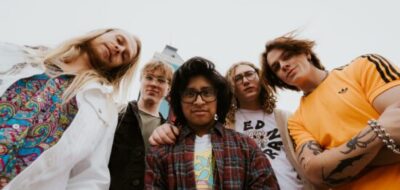We have all been living in a world turned upside down for the past year. Those truly dedicated to their music have been able to focus on their art and create some amazing things. Our friend Richard Demko has had his head down hard at work and is now ready to share some amazing music with the world.
We caught up with the talented producer, composer, and label executive for a chat to get deeper into his story. Enjoy the interview here:
What first drew you to this crazy idea of making music?
It all started back when I was 5 years old. I was raised by my Grandparents and went to live with them at the age of 4 years old. My aunt had left a piano at my Grandparents’ house when she moved abroad, and I just started playing around with it. My grandparents saw I had an interest in the instrument, so they made some sacrifices to get me piano lessons. One thing led to the next, and after a few years of learning the piano, I started experimenting with ideas I had floating around in my head. I wrote my first song when I was 6. It wasn’t anything spectacular, just a few chords and a melody that repeated for like 42 bars or something like that, but it started off a journey that I’m still on. I then went on to learn drums, which I began playing in 5th grade band all the way through to senior year.
In middle school, I put together a garage band, and self taught myself to play guitar, bass and violin. In the early 2000’s I learned the art of engineering and production when the band I was playing in at the time went into Horizon Studio to record an album. When the sessions were over, the guys all left, but I stayed around and worked as an intern learning everything I could from one of our area’s greatest producers, Vic Steffens. Eventually, I worked my way up to a full time engineer, started dabbling in live sound, and took a short-term job working as the talent buyer for Toads Place. I started a small indie record label in 2019 called NeuroTronix Records where I took all the skills, knowledge, and connections I made throughout the years and turned it into one giant musical family.
How would you describe your sound?
That is a very hard question, as I really don’t have a defined sound. I write, play and record basically everything. I am not really committed to a genre, as I write whatever comes to mind based on the mood and mindset I am in at the time. I have written everything from Metal to Classical Contemporary with everything in-between. My primary focus is writing music for film trailers and advertising these days, however, I do write for other artists all across the genre spectrum. I can say that when writing for sync pitches, I tend to like the big orchestral sound and thunderous percussion aspects, but it’s really job-specific, and certain jobs & pitches require certain vibes & sounds based on the mood of the visual, or what the artist is looking for in co-writing or commissioned situations.
Which artists have had the biggest influence on you?
As someone who is a multi-instrumentalist that writes in many different genres, I have influences all over the musical palate. My biggest influences as writers & performers are The Beach Boys/Brian Wilson, Yanni, Dream Theater, Bach, Brahms, Evanescence, The Grateful Dead, and Metallica just to name a few. For production and technical influences I will say Brian Wilson as a producer, Phil Spector (FOR HIS PRODUCTION ONLY), Butch Vig, Berry Gordy, Paul Epworth, Sir George Martin, Dr. Dre, Quincy Jones, Sam Phillips, and obviously my mentor Vic Steffens.
You notice I mention Brian Wilson a few times, and overall he has had the biggest influence in my personal musical taste. I was about 5 years old when I first heard The Beach Boys. My father had left a double live album on vinyl at my grandparents’ house that is known amongst the diehard Beach Boys fans as, “Appeal To The Great Spirit.” That album really shaped the way I heard things, and even though I was so young, I knew that there was something very special about the songs, the sound, the vocals, the instrumentation and the overall vibe of that record. As fate may have it, I had the pleasure of working with Blondie Chaplin last year, who first appeared with the Beach Boys on that live album, and I was blessed with the opportunity to lay down all the B3 organ parts on the songs he recorded with The Name Droppers’ guitar player and primary writer (and my friend) Rafe Klein at Horizon Music Group, with Vic Steffens at the helm of the project. I have maintained a very close personal relationship with Blondie, and we will be doing some more stuff together musically once this pandemic is a thing of the past.
What have you been able to do with the ‘downtime’ that a worldwide pandemic has caused?
I have been very fortunate to be able to maintain throughout the pandemic, and I am very blessed to be able to say that. I know it’s been rough for many in the business. So many artists and musicians are struggling, along with all of the local venues due to restrictions on live music in my area. Although the booking end of the label took a hit, promotions, remote mixing, custom writing, and the occasional socially distanced tracking session have been steady. Again, I am very blessed to be working with some really great clients that have kept me busy throughout this whole ordeal. Because of this steady flow of work, I have done what I can to help the scene recover. I’ve made it a point to support as many local bands as I can by adding their music to my somewhat popular Spotify playlist, purchasing their merch, and doing the virtual tip jar thing when I see locals doing live streams. I’ve made countless monetary donations to various musical funds in the area (employee relief funds at various venues that have supported me and my artists, save our stages, etc.). I will never forget where I came from and who helped get me to where I am now, and I will always do what I can to give back to the community and to the local scene.
How does a song come to you? Take us through your process.
Location, environment, mood, scenery, images, art, physical & fictitious places, people…these all play a big part in generating ideas for songs, or pieces of songs. Like many, my cell phone is connected to me at the hip 24/7, and with that I am always jotting down ideas in notes, and humming/singing melodies into the voice memos. I have a routine where I write and record something almost every day, whether it’s a 30 second advertising cue, a two and a half minute epic film trailer, or a 4-minute song for either myself or one of my writing clients. I find that doing this every day helps keep my playing chops up, it adds music to my extensive catalogue, and it keeps my creative juices flowing. Sometimes an idea comes to me while I’m driving, sometimes in the shower, sometimes while I’m just hanging out, but I’ve found that most of my best work has come right when I am laying down to go to bed.
You have been able to run the gamut from writing full songs for bands to writing short instrumentals for sync placement. How do you attack each differently?
Writing full songs for bands generally has a much different structure than writing for sync. With full band songs, it’s a bit looser and more free-form. There is still structure, but not as stringent. With sync, there are “rules” that have to be followed, and that all depends on the application. For example, when writing a trailer it’s based around a 3 (or sometimes 4) act piece where you start with an intro that leads to a break (for editing purposes), then the main idea is introduced that builds in intensity leading to a huge 3rd part finish with a cliffhanger ending. If a client requests a 4th act, then that’s usually even bigger than the climax at the end of the third so you have to make sure you have enough in the tank to be able to build a huge ending that grabs the attention of the listener without giving it all you have throughout the third act.
For advertising, there are also another set of “rules” mainly revolving around time lengths. Most advertising pieces are between 30 seconds and 1 minute so you have to be able to tell your story in a very short period of time. When writing full band songs, you really do not have any time constraints, especially now with the digital age taking over from the FM radio era. Gone are the days where the only way your song is going to get exposure is if it’s less than 4 minutes in length. Sure, if you want to target FM radio for marketing then it’s a good idea to keep the songs between 3-4 minutes, but at the end of the day, digital distribution and online radio has allowed artists and musicians to tell an even more colorful story.
To be able to switch gears between writing full band stuff vs. stuff for sync takes discipline and it’s something that just doesn’t happen. When you go to lay down something, you have to go into it with a totally clear mind and have a solid objective so you do not get sidetracked and end up producing something completely different than what you initially intended to produce. I work well under pressure, but some musicians do not, and if your plan for the day is to write something for sync, then that is all you should focus on leading up to, and during the session- especially if you have a client with a deadline.
Your most recent release “Someone To Be By My Side” definitely seems to have been influenced by the current situation. What do you hope the listener can take away from the song?
Yes, my most recent single “Someone To Be By My Side” was influenced by the current situation, and its main takeaway is that it’s ok to have feelings, it’s ok to cry out for help and that no one is alone in any of this (or anything for that matter). That song originally started out as an instrumental, but the more I messed with it, the more I felt that it needed some strong lyrics. I took some thoughts that I had jotted down throughout the pandemic and I put them all together in context with the music. Normally I’ll get a session singer or one of my collaborators to sing on my stuff, but with social distancing being a huge priority for me that wasn’t going to happen any time soon, so I decided to sing it myself and release it under my label.
We hear you have a full orchestral piece coming in March. What can you tell us about it?
The name of the piece is “Through Time And Space” and it’s a 6½ minute music journey that started 7 years ago. It’s one of the many ideas I had laid down that I didn’t really have a solid plan for, and it was filed as an orchestral idea to be used for something else that may come up in the future. After cleaning up and going through my numerous storage drives, I came across the track file and I decided to revisit it a few months ago. The fresh perspective gave me what I needed to finish it. I was pretty pleased with what came out so I decided to release it and share with the world what goes on in my crazy mind. This will be the first piece of orchestral music that I will be making available to the public, and I figured that if it goes over well, I may release some more orchestral works in the near future.
Give us a look at more of the future for you?
On a typical day, I have lots going on between writing, recording, and producing, along with running the label. With venues preparing for outdoor music series starting in the spring, I have been booking lots of those outdoor shows for the artists that I work with. My label also has a few albums in the queue that I will be recording, there is some stuff that’s finished that will be released & promoted, and hopefully lots of sync placements for my own work. As for full-length songs of my own, I plan on releasing some of the things I’ve written throughout the pandemic as part of what I call “The Quarantine Sessions.” Personally, I am looking forward to the return of live music, and I am also looking forward to taking a nice long vacation with my family & getting away to the woods camping this spring for some much needed relaxation.
Keep up with more from Richard Demko HERE.









